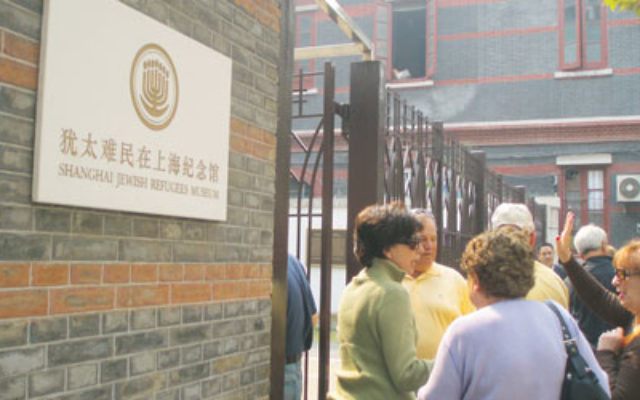From Western Wall to the Great Wall …
CHINA has been a haven for Jewish refugees escaping both the terrors of Russian pogroms in the early 20th century and the rise of Nazism a few decades later.
During World War II, Shanghai’s Jewish population swelled to more than 30,000 people, mainly due to it remaining an open port at a time when most of the world closed its doors to Jews fleeing persection.
Despite the harsh living conditions, the Jewish community thrived. In fact, part of the ghetto became known as “Little Vienna”.
After the war, most of the Jews dispersed, including a sizeable number settling in Australia, and left behind an important legacy which today continues to fascinate tourists.
Article cont’d below video
While Shanghai proved a haven during World War II, it was the northern city of Harbin that became a sanctuary for Russian Jews fleeing the pogroms in the early 1900s.
By 1929, the city’s Jewish population was about 13,000 and today the remnants of the thriving community can be seen in the synagogues, commercial buildings including an old Jewish bank, and the cemetery.
In Kaifeng, Jewish traders travelling on the Silk Road about 1000 years ago settled in the city. In 1163, a synagogue was built. Memories and memorabilia of Jewish life are on display in the Kaifeng Jewish Museum.
The historic Jewish sites of Shanghai, Harbin and Kaifeng are highlights of a new Jewish Heritage Tour of China that is taking place from late October to early November.
The 16-day trip is being organised by Helen Wong’s Tours, a leading Sydney-based tour operator which next year celebrates its 25th anniversary of taking Australian tourists to China.
Earlier this year, company founder Helen Wong was honoured at a function in Melbourne by the Shanghai Municipal Tourism Administration for becoming the first Australian tour operator to reach the milestone of arranging travel for 200,000 Australians to visit Shanghai.
“The heritage tour offers a fascinating insight into China’s Jewish history,” she says.
China has many iconic tourist attractions that attract millions of visitors each year, including the majestic Great Wall, Beijing’s Forbidden City and the underground tombs of the terracotta warriors in Xian – all included in the Jewish Heritage Tour.
The tour starts in Shanghai, a bustling city of more than 20 million people. Its ever-changing skyline is testament to a building program that reputedly accounts for 20 per cent of the world’s construction cranes.
The best way to appreciate Shanghai’s Jewish history is with a tour conducted by Dvir Bar-Gal, an Israeli photographer/journalist who has lived in Shanghai for several years.
His half-day tour, which is included in the Jewish Heritage Tour of China, starts at the recently refurbished Peace Hotel on the Bund, then tours the Hongkou district (known as the Shanghai Ghetto) and visits the Ohel Moishe Synagogue, home
to the Shanghai Jewish Refugees Museum.
Shanghai has another shul, the majestic Ohel Rachel Synagogue built by the Sassoon family in 1920 for the Sephardic community and used until 1952. However, since 2002 the Ohel Rachel synagogue has been closed to the public.
Nearby is the Shanghai Jewish School, which was transferred to its current site in 1932 by Horace Kadoorie and is now part of the Shanghai municipal education commission.
Shanghai is renowned for its shopping, vibrant nightlife and restaurants. Take a ride on the Maglev, a passenger train that reaches a top speed of more than 400kmh.
Beijing has a host of tourist attractions and tour participants can visit the Great Wall, the Forbidden City and the wondrous Summer Palace, the Sacred Way with the Ming tombs, and walk around the vast Tiananmen Square which houses Mao’s mausoleum.
Tour the hutungs by cycle rickshaw for an insight into the traditional Chinese way of living.
Beijing has a population of about 2000 Jews, boosted by more than 10,000 Israeli or Jewish visitors annually.
Earlier this year Chabad opened a $3 million community centre in Beijing that includes a museum, shul, kosher restaurant, internet café and offices.
The Bet Yaakov Chabad House and Community Centre has a façade that resembles a synagogue and the museum features hundreds of Jewish-Chinese artefacts from around the world.
For more information on the Jewish Heritage tour of China, contact Helen Wong’s Tours on 1300 788 328 or visit www.helenwongstours.com.
REPORT by AJN Travel Editor Danny Gocs, who is joining the tour to produce a special souvenir book for participants and report on the tour.
PHOTO: Visitors to the Shanghai Jewish Refugees Museum and former Ohel Moishe synagogue. Photo: Danny Gocs


comments